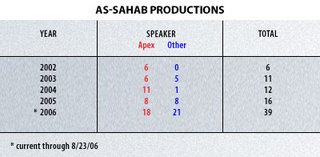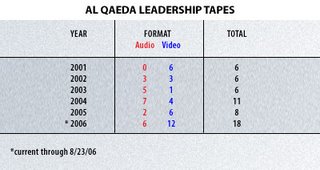OSINT: Stratfor on Al-Qaeda media
The good people at Stratfor has once again come up with an interesting report, based mostly on OSINF. Below I reproduce it in full. Please visit www.stratfor.com and sign up for their newsletters.
Al Qaeda Recordings: Semantic Noise and Signals
By Fred Burton
Al Qaeda has released a record number of messages this year through its as-Sahab media arm, threatening attacks in a variety of places. In fact, it would appear that al Qaeda leaders have threatened jihadist operations in more places than the organization -- even through its regional affiliates and grassroots sympathizers -- may be capable of hitting.
Viewed in proper perspective, meaning neither ignored by blase analysts nor magnified by the media or public, these messages can convey many important signals about the state of al Qaeda today. The volume trends alone are interesting; in fact, we find them to be at least as significant as the content of the messages from Osama bin Laden and Ayman al-Zawahiri, if not in some cases more so.
The number of messages issued by bin Laden and al-Zawahiri have reached record levels in 2006, and the total number of videos produced by as-Sahab also has increased.

These volumes likely stem at least in part from changes in the way al Qaeda chooses to broadcast its statements to the world. Whereas it once took the considerable risks of smuggling tapes to commercial broadcasters such as Al Jazeera, it now is uploading its own statements directly to the Web. These methods give the organization greater control over when -- and how much of -- its statements reach the public.
Obviously, the content of the messages is important, and is generally broadcast around the world in fairly short order by mainstream news organizations. So far this year, bin Laden and al-Zawahiri have threatened the "Crusader-Zionist" alliance many times, and on one occasion added India to the mix by threatening strikes against those perpetrating the "Crusader-Zionist-Hindu" conspiracy against Muslims. The public statements also have touched on a number of different locales -- from bin Laden's Jan. 19 recording that threatened attacks in the United States to calls to "establish jihad" in Iraq, Palestine, Afghanistan, Sudan, Kashmir, Chechnya, Sudan, Somalia, Pakistan and Egypt. Al Qaeda leaders also have called for the overthrow of several Muslim leaders, including Pakistani President Gen. Pervez Musharraf and Afghan President Hamid Karzai.
However, despite this flood of rhetoric, the number of attacks carried out by al Qaeda or its affiliates has actually fallen on a year-by-year comparison. By this time in 2005, there had been suicide bombings in Doha, Cairo, Sharm el-Sheikh and London, a second, unsuccessful attack in London and a rocket attack in Aqaba, Jordan. To date in 2006, there has been a strike against the Abqaiq oil processing facility in Saudi Arabia (February), a car bomb attack near the U.S. Consulate General in Karachi (March), and the tourist resort bombings in the Sinai (April). There does not appear to be a solid correlation between the number of statements released and actions -- even when thwarted attacks, such as the recently uncovered airliner plot in London, are accounted for. It also is worth noting that all of these listed strikes and attempts involved al Qaeda's regional affiliates or grassroots sympathizers, rather than "all-star teams" such as the one deployed for the 9/11 attacks.
Tellingly, it is not only the quantity of messages being produced by as-Sahab that is rising, but the quality as well. As-Sahab is using professional-grade gear and studio-quality lighting for its productions. Even in-the-field footage captured in places like Afghanistan and Egypt displays a professional level of post-production editing, crisp graphics and, quite often, added subtitles in a second language. As any comparison to popular clips at sites like YouTube or MySpace will show, as-Sahab videos are not being produced by an amateur at home using a personal computer and a cheap camcorder.
Reading the Numbers
Both the numbers and the quality of the recordings being issued by al Qaeda's apex leadership this year can be read as an indication of a growing comfort level. The atmosphere is very different now than, for example, in 2002, when the organization's sanctuary in Afghanistan had been newly disrupted and key figures were scattered, seeking new places of safety. At this point, al Qaeda's leaders appear to feel safe and believe that issuing greater volumes of recordings will not compromise their hiding places.
The comfort level seems most apparent with al-Zawahiri, who issues more statements than does bin Laden and usually appears on video. Bin Laden has not been seen on video since late October 2004 (though as-Sahab often places his audio recordings into a video format, usually alongside a still photo of the speaker). Many have speculated that his reluctance to appear on film could be related to declining health; however, it also is possible that he is in a more remote location than al-Zawahiri, where the appearance of a camera or video crew might bring unwanted attention. Or perhaps both factors are at work. Either way, there have been numerous indications over time that bin Laden and al-Zawahiri are in separate locations -- something that would be dictated by prudent operational security, if nothing else.
There are other notable differences between the messages of bin Laden and those of al-Zawahiri, including time lags between dates of recording and release. Three weeks generally appear to elapse between the recording and distribution of bin Laden's audio tapes, whereas al-Zawahiri's videos take only two. This too indicates that bin Laden is further removed from society than is al-Zawahiri, or that the path taken from bin Laden to as-Sahab is more convoluted for security reasons. Or, again, perhaps a combination of both.
Extending this line of thinking, common-sense security measures would dictate not only separation between bin Laden and al-Zawahiri, but also between the two men and as-Sahab's production facility. Al-Zawahiri seems to be able to link up with the as-Sahab video crews more readily than bin Laden -- and as-Sahab appears to be based in a location where technicians have access to a professional video studio. Even if it is hidden in a large home or warehouse, it still would require a reliable power supply and supplies of other staples -- such as replacement bulbs for studio lights, modern materials for the stylish sets featured in videos and access to a photo studio capable of producing the very large, professional-looking images like those in the backdrop of al-Zawahiri's July 27 video.
The quality of the video messages speaks to something else as well. When posted to the Internet, the files are very large -- so clearly, whoever is doing so has a high-speed Internet connection. The general principle is that the longer an upload takes, the greater the exposure of, and risk to, the person doing the uploading. Also, because these files often are encoded in a number of formats, with varying file sizes and quality, as-Sahab technicians clearly are uploading numerous files with each video release. The risks incurred increase every time they do so.
The obvious conclusion is that al Qaeda not only has high-speed Internet connections, but competent, clandestine IT support as well. Given the large number of statements released this year, it is clear that as-Sahab personnel are confident in the security of their channels -- and, indeed, there has been no major breach of their distribution system since the possible compromise in January at Damadola.
Finding the Balance
When al Qaeda first began publicly declaring its intentions of waging war against the United States, most Americans were unaware of the statements -- and those who were tended to snicker at the hubris. Very few expected any actual attempts by bin Laden or his companions to fulfill the threat. That logic began to reverse as major operations -- such as the 1998 embassy bombings in East Africa, the millennium bomb plot and the USS Cole strike -- were enacted, and the 9/11 attacks cemented al Qaeda's image as a serious adversary. Now, most people assume that when al Qaeda makes a threat, there will be sincere attempts to carry it out.
In fact, the psychological impact of the 9/11 attacks led to another problem, exactly the opposite of the first: system overload. Shortly after 9/11, there were floods of erroneous reports that messages from bin Laden and other leaders contained secret symbols and attack signals, or even hidden steganographic files -- data that can be inserted into jpeg images or video files. Such clandestine communication methods -- using hidden signals in mass media -- were useful during the World War and Cold War eras, but in the age of the Internet and the "clone phone," these techniques not only are unnecessary, but carry far more risk than prudence on al Qaeda's part would allow.
What, then, is to be made of all these messages from al Qaeda leaders? As usual, the truth lies somewhere between the extremes: The messages are neither empty rhetoric nor secret attack instructions. Al Qaeda's recordings genuinely convey the group's general intent and frequently serve as a window into the leadership's mindset and philosophy. It is possible to determine what the leaders believe is important and where they are focusing their attention. However, the messages rarely contain precise threats against specific targets. They are generalities, crafted with two audiences -- al Qaeda's chosen enemies and potential allies -- in mind.
Through this lens, and with the aid of hindsight, it is easy to see a correlation between al-Zawahiri's July 27 video and the thwarted London plot. The general message that al Qaeda wanted to stage an attack to eclipse 9/11 -- even twice as large -- is not difficult to decipher. The more subtle message that al Qaeda remains fixated on aircraft was also there. However, there was nothing in the al-Zawahiri message that would have led to the identification or compromise of the U.K. planes operation. It was a general message, not a specific one.
Given the volume of messages this year, it is clear that al Qaeda generally remains interested in operating through regional affiliates and grassroots sympathizers, and in encouraging strikes in the regions it has named. However, with a few exceptions (such as oil infrastructure in the Middle East), the leadership has not named specific targets. Therefore, we must assume that within these geographic areas, al Qaeda will continue to adhere to its well-established target set: planes, trains and hotels.
From al Qaeda's perspective, this is a tremendously effective strategy. Recognizing that governments cannot protect everything -- or even the limited target set that the leadership has named publicly -- there always will be soft targets available. And if governments or the private sector were to attempt to protect all imaginable targets within their spheres, the principle of economic warfare still applies. Al Qaeda long has aspired to cripple Western powers -- particularly the United States -- economically, since it is from financial wealth that so many other forms of strength are derived.
Send questions or comments on this article to analysis[ad]stratfor.com.
Go to https://www.stratfor.com/subscriptions/free-weekly-intelligence-reports.php to register
Distribution and Reprints
This report may be distributed or republished with attribution to Strategic Forecasting, Inc. at www.stratfor.com. For media requests, partnership opportunities, or commercial distribution or republication, please contact pr@stratfor.com.
© Copyright 2006 Strategic Forecasting Inc. All rights reserved.




0 Comments:
Post a Comment
<< Home